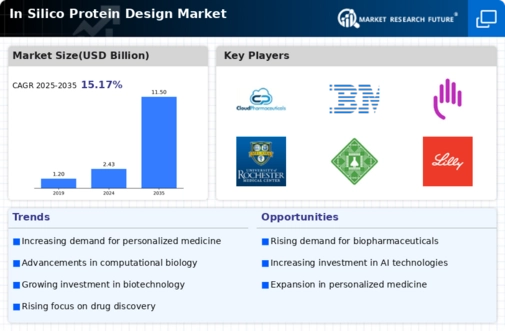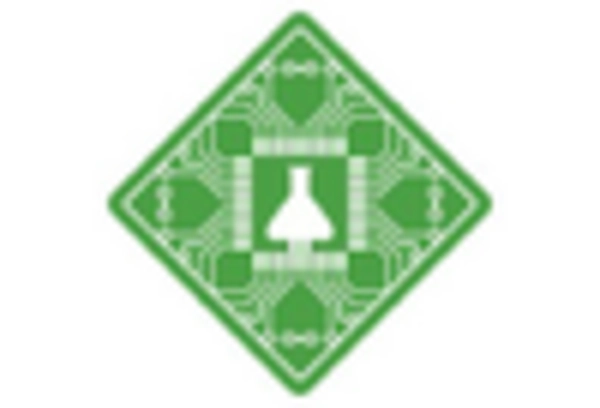Rising Demand for Biopharmaceuticals
The increasing demand for biopharmaceuticals is a primary driver of the In Silico Protein Design Market. As the healthcare sector shifts towards biologics, the need for innovative protein design becomes critical. In 2025, the biopharmaceutical market is projected to reach approximately 500 billion USD, indicating a robust growth trajectory. This surge necessitates advanced protein design techniques to develop effective therapeutics. In silico methods allow for rapid prototyping and optimization of protein structures, significantly reducing the time and cost associated with traditional experimental approaches. Consequently, the integration of in silico protein design is likely to enhance the efficiency of drug development processes, thereby attracting investments and fostering collaborations within the In Silico Protein Design Market.
Increased Focus on Sustainable Practices
The growing emphasis on sustainability within the biotechnology sector is driving the In Silico Protein Design Market. As industries seek to minimize their environmental impact, the demand for sustainable protein production methods is rising. In silico protein design offers a pathway to develop proteins that can be produced in more environmentally friendly ways, reducing waste and resource consumption. This trend aligns with global sustainability goals and is likely to attract funding and support from various stakeholders. By leveraging in silico approaches, companies can optimize protein production processes, leading to more efficient and sustainable biomanufacturing practices. This shift towards sustainability is expected to enhance the competitive landscape of the In Silico Protein Design Market.
Advancements in Computational Technologies
The rapid advancements in computational technologies are significantly influencing the In Silico Protein Design Market. Enhanced computational power and sophisticated algorithms enable researchers to simulate complex proteinteractions and predict their behavior with remarkable accuracy. As of 2025, the market for computational biology tools is expected to exceed 10 billion USD, reflecting the growing reliance on computational methods in biological research. These technologies facilitate the design of novel proteins with desired functionalities, which is essential for various applications, including enzyme engineering and vaccine development. The continuous evolution of machine learning and artificial intelligence further augments the capabilities of in silico protein design, making it a pivotal component in the future of biotechnology.
Growing Investment in Research and Development
The increasing investment in research and development (R&D) across the biotechnology sector is a significant driver of the In Silico Protein Design Market. As organizations recognize the potential of in silico methods to accelerate innovation, funding for R&D initiatives is on the rise. In 2025, global R&D spending in biotechnology is anticipated to surpass 300 billion USD, highlighting the sector's commitment to advancing scientific knowledge. This influx of capital enables the development of cutting-edge in silico tools and technologies, fostering a more dynamic and competitive market environment. Furthermore, collaborations between academic institutions and industry players are likely to enhance the capabilities of in silico protein design, driving further advancements in the field.
Regulatory Support for Innovative Technologies
Regulatory bodies are increasingly recognizing the importance of innovative technologies in the biotechnology sector, which is positively impacting the In Silico Protein Design Market. Supportive regulatory frameworks are being established to facilitate the adoption of in silico methods in drug development and protein engineering. As of 2025, several countries are expected to implement guidelines that promote the use of computational approaches in regulatory submissions, streamlining the approval process for new therapeutics. This regulatory support not only encourages investment in in silico technologies but also enhances the credibility of these methods within the scientific community. As a result, the In Silico Protein Design Market is likely to experience accelerated growth as more organizations adopt these innovative approaches.


















Leave a Comment